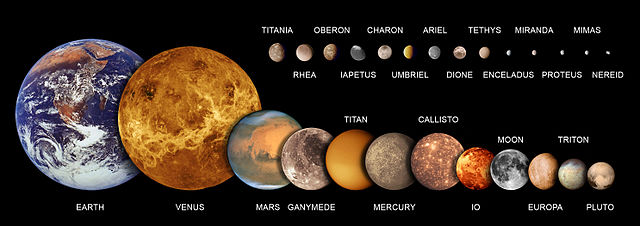A planetary-mass moon is a planetary-mass object that is also a natural satellite. They are large and ellipsoidal in shape. Moons may be in hydrostatic equilibrium due to tidal or radiogenic heating, in some cases forming a subsurface ocean. Two moons in the Solar System are larger than the planet Mercury : Ganymede and Titan, and seven are larger and more massive than the dwarf planets Pluto and Eris.
Planetary-mass moons larger than Pluto, the largest Solar dwarf planet.
A planetary-mass object (PMO), planemo, or planetary body is, by geophysical definition of celestial objects, any celestial object massive enough to achieve hydrostatic equilibrium, but not enough to sustain core fusion like a star.
The planetary-mass moons to scale, compared with Mercury, Venus, Earth, Mars, and Pluto (the other planetary-mass objects beyond Neptune have never been imaged up close). Borderline Proteus and Nereid (about the same size as round Mimas) have been included. Unimaged Dysnomia (intermediate in size between Tethys and Enceladus) is not shown; it is in any case probably not a solid body.
Planetary-mass satellites larger than Pluto, the largest Solar dwarf planet.
The dwarf planet Pluto
Artist's impression of a super-Jupiter around the brown dwarf 2M1207.




